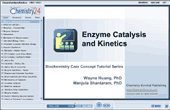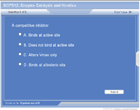Enzyme Catalysis and Kinetics
| Topic Review on "Title": |
Enzyme catalysis
Enzymes act by lowering the activation energy. They do not change the equilibrium of the reactions. Enzyme binds with the substrate to form an unstable complex which breaks up into products liberating enzymes. Lock and key theory and induced fit theory explain the enzyme-substrate complex formation. Small region on the enzyme where the substrate binds and catalysis takes place is called an active site. Enzymes are highly specific in their action. Three types of enzyme specificity are well recognized: They are stereo specificity, reaction specificity and substrate specificity. There are different mechanisms to explain enzyme catalysis. Different mechanisms are: acid base catalysis, covalent catalysis and metal ion catalysis and transition state stabilization.
Enzyme kinetics
Various factors like concentration of substrate, pH and product concentration of products affect enzyme activity. Michaelis-Menten kinetics is based on substrate concentration. When a graph is plotted for substrate concentration [S] on x-axis and velocity [V] on the y axis, a rectangular hyperbola is obtained. A linear plot that is obtained by rearranging the M-M equation is called Lineweaver-Burk plot or double reciprocal plot. Km value is the substrate concentration at half maximal velocity of an enzyme catalyzed reaction. Enzymes having many subunits may not strictly follow the M-M kinetics. Chemical substances which inhibit enzyme activity and reduce velocity of an enzyme catalyzed reaction are known as inhibitors. Enzyme inhibition is broadly classified into reversible and irreversible inhibition. Reversible inhibition is further divided into competitive, non competitive and uncompetitive inhibition. Suicide inhibition is a reversible inhibition.
Regulatory Properties of Enzymes
In each enzyme system, there is at least one enzyme that catalyzes the rate limiting reaction. It is known as a regulatory enzyme. There are two major classes: Allosteric enzymes acting through reversible, non covalent modulator. Enzymes regulated by reversible covalent modification. The allosteric sites are different from its active site. Feedback inhibition is the best example for allosteric modulation. Localization of enzymes related to one pathway partly in mitochondria and partly in cytosol is called compartmentation. Ribozymes are the enzymes made of RNA.
|
| Rapid Study Kit for "Title": |
| Flash Movie |
Flash Game |
Flash Card |
| Core Concept Tutorial |
Problem Solving Drill |
Review Cheat Sheet |
 |
 |
 |
|
| "Title" Tutorial Summary : |
Enzymes act by lowering the activation energy. They do not change the equilibrium of the reactions. Enzyme binds with the substrate to form an unstable complex which breaks up into products liberating enzymes. Small region on the enzyme where the substrate binds and catalysis takes place is called an active site. Enzymes are highly specific in their action. There are different mechanisms to explain enzyme catalysis. Various factors like concentration of substrate, pH and product concentration of products affect enzyme activity. Michaelis-Menten kinetics is based on substrate concentration. Enzyme inhibition is broadly classified into reversible and irreversible inhibition. Enzymes do have regulatory properties. Ribozymes are the enzymes made up of RNA.
|
| Tutorial Features: |
- Concept map to show the factors influencing the rate of biochemical reactions and mechanism of catalysis.
- Michaelis-Menten theory and hypothesis explained with animations.
- Enzyme specificities are discussed with suitable reactions and examples.
- Enzyme kinetics plots are animated and easy to understand.
- Regulation of enzyme activity is explained with interesting examples.
|
| "Title" Topic List: |
Enzyme Catalysis
- Introduction
- Mechanism of enzyme action
- Enzyme-substrate complex and active site
- Enzyme specificity
- Mechanisms of catalysis
Enzyme Kinetics
- Factors affecting enzyme activity
- Michaelis-Menten kinetics
- Inhibition
Regulatory Properties of Enzymes
- Introduction
- Irreversible covalent activation
- Reversible covalent modification
- Allosteric modulation
- Compartmentation
- Ribozymes
|
See all 24 lessons in college chemistry, including concept tutorials, problem drills and cheat sheets:
Teach Yourself Biochemistry Visually in 24 Hours |



